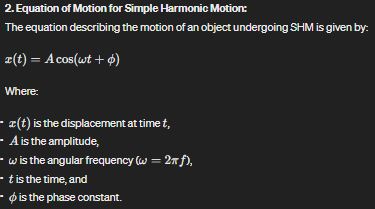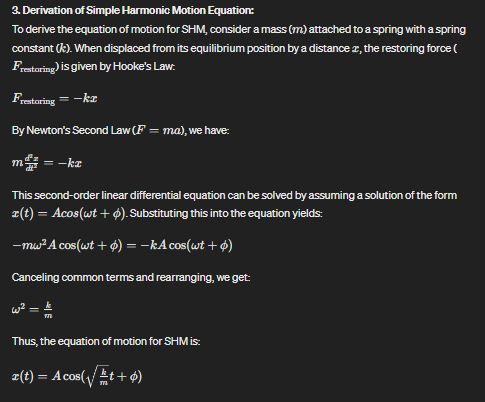Website can be closed on 12th to 14th Jan 2025 due to server maintainance work.
Understanding Simple Harmonic Motion and its Derivation
Introduction:
Simple Harmonic Motion (SHM) is a fundamental concept in physics that describes the repetitive back-and-forth motion exhibited by certain systems under the influence of a restoring force. This type of motion is prevalent in various natural phenomena, such as the oscillation of a pendulum, the vibration of a guitar string, or the motion of a mass-spring system. In this assignment, we will delve into the principles of Simple Harmonic Motion, exploring its characteristics, equations, and deriving the fundamental equation governing SHM.
1. Characteristics of Simple Harmonic Motion:
Simple Harmonic Motion is characterized by several key features:
- Restoring Force: SHM occurs when a restoring force proportional to the displacement from the equilibrium position acts on an object. The restoring force aims to bring the object back to its equilibrium position.
- Linear Restoring Force: The restoring force is directly proportional to the displacement from the equilibrium position and acts in the opposite direction to the displacement.
- Periodic Motion: The motion repeats itself in equal intervals of time, leading to a periodic behavior.
- Amplitude: The maximum displacement from the equilibrium position is known as the amplitude.
- Frequency and Period: Frequency (f) is the number of oscillations per unit time, and the period (T) is the time taken for one complete oscillation. They are inversely related: (f = 1/t).


Conclusion:
Simple Harmonic Motion is a crucial concept in physics, describing the oscillatory behavior of various systems. The derivation of its equation provides insight into the interplay between mass, spring constant, and displacement. Understanding SHM is essential for comprehending a wide range of physical phenomena and engineering applications.
